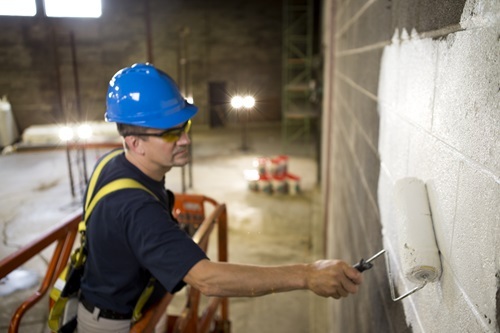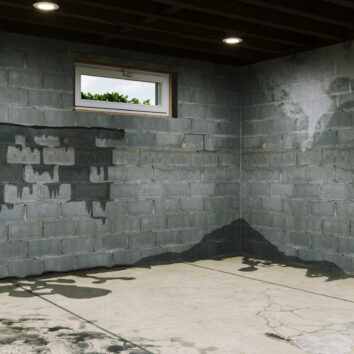Let’s face it — few things are more frustrating than gearing up for a big home improvement project, only to realize halfway through that you don’t have enough material. Waterproofing your basement is no exception. It’s a big job, and running out of product mid-project can leave you stuck — literally and figuratively.
Thankfully, DRYLOK® makes it easy to avoid that headache with a Coverage Calculator that helps you estimate exactly how much you’ll need to get the job done right the first time. But before you dive in, it’s important to understand the factors that impact how much product you’ll really need.
To achieve a deeper color and bring out a soft sheen, apply a second coat.
All products listed here are available in gallons, some also come in 5 gallon containers, and others are packaged in pints (8 pints = 1 gallon) and/or quarts (4 quarts = 1 gallon). The number of coats recommended is intended to provide the best possible coverage and meet warranty qualifications, if applicable. This calculator was designed to generate an approximation of the amount of product required and should only be used for estimating purposes. The amount may change depending on the application, the condition of the surface, and other variables. If you have questions about our products or would like to discuss your project, please call our Customer Service Team at 1-800-272-3235 (Monday-Friday, 8am-5pm Eastern) or email ugllabs@ugl.com.
Also, don’t forget to share your success stories on social media and tag us with #DRYLOKWATERPROOFER. We’d love to see your handiwork!

Know Your Substrate
Not all walls are created equal. The type and condition of your basement walls significantly affect how much waterproofing product you’ll need.
- Concrete block is porous and usually requires more product to fully seal.
- Poured concrete tends to have a smoother surface and often uses less.
- Previously painted surfaces may affect adhesion and coverage.
- Rough or unsealed surfaces can absorb more product, reducing overall coverage per gallon.
If your walls are old, chalky, or have been previously damaged by water, you might need extra coats or even some prep work like patching or cleaning before applying the waterproofing product.
Don’t Forget the Coats
For maximum effectiveness, DRYLOK® waterproofers require two coats. That’s not just a recommendation — it’s part of how the product works to keep moisture out. Keep that in mind when calculating how much you’ll need.

How much product do you need?
Make Sure You’ve Identified the Right Problem First
Before you start rolling on the waterproofing paint, take a step back and make sure you’re solving the right problem. Not all basement moisture issues are caused by the same thing, and applying a waterproofing product to the interior walls won’t fix exterior drainage problems or plumbing leaks.
Here are a few key things to check:
-
Surface Condensation: Sometimes what looks like a leak is just humidity collecting on cool basement walls. If that’s the case, improving ventilation or running a dehumidifier might be the first step.
-
Plumbing Leaks: Check for leaking pipes, appliances, or fixtures that could be causing water buildup.
-
Gutters & Downspouts: Clogged gutters or improperly directed downspouts can dump water near your foundation, eventually seeping inside.
-
Grading Around the House: The ground around your home should slope away from the foundation to keep water from pooling and pushing inward.
-
Cracks and Structural Issues: If you see large cracks or bowing walls, it might be time to call in a foundation expert before applying any waterproofing coatings.
Waterproof coatings like DRYLOK® are designed to stop water infiltration through walls, but they work best when part of a comprehensive moisture control plan. Make sure you’re not just treating the symptom instead of the source.

Find Solutions to Common Basement Problems
Final Tips
Identify the current problems and product needed.
-
Always buy a little extra, just in case — especially if you have rough or irregular surfaces.
-
Don’t skip prep work. Clean, dry surfaces help maximize coverage and adhesion.
-
Follow all product directions for drying time between coats and application methods.


